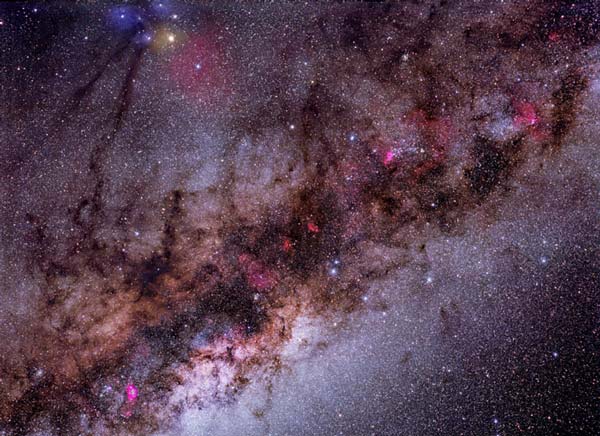Credit & Copyright: John P. Gleason,
Celestial Images
Explanation:
The disk of our
Milky Way Galaxy is home to hot nebulae,
cold dust, and billions of stars.
The red nebulae visible in the above contrast-enhanced picture are primarily
emission nebulae, glowing clouds of
hydrogen gas heated by nearby, bright, young stars.
The blue nebulae are primarily
reflection nebulae,
clouds of gas and fine dust reflecting the light of
nearby bright stars.
Perhaps the most striking, though, are the areas of darkness,
including the Pipe Nebula
visible on the image top left.
These are lanes of thick dust,
many times containing relatively cold
molecular clouds of gas.
Dust is so plentiful that it obscures the
Galactic Center in visible light,
hiding its true direction until discovered
early last century.
The diffuse glow comes from
billions of older,
fainter stars like our
Sun, which are typically much older than any of the nebulae.
Most of the mass of
our Galaxy remains in a form currently unknown.
1999 2000 2001 2002 2003 2004 2005 2006 2007 2008 2009 2010 2011 2012 2013 2014 2015 2016 2017 2018 2019 2020 2021 2022 2023 2024 2025 |
Yanvar' Fevral' Mart Aprel' Mai Iyun' Iyul' Avgust Sentyabr' Oktyabr' Noyabr' Dekabr' |
NASA Web Site Statements, Warnings, and Disclaimers
NASA Official: Jay Norris. Specific rights apply.
A service of: LHEA at NASA / GSFC
& Michigan Tech. U.
|
Publikacii s klyuchevymi slovami:
Milky Way - gas - dust - Mlechnyi Put' - gaz
Publikacii so slovami: Milky Way - gas - dust - Mlechnyi Put' - gaz | |
Sm. takzhe:
Vse publikacii na tu zhe temu >> | |
